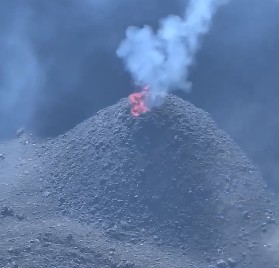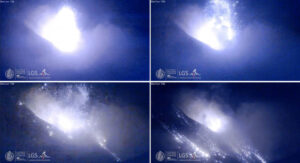 Yesterday evening at 20:04 a major explosive eruption occurred on Stromboli. Glowing tephra covered the crater and its southern flank. However, it is not yet clear whether larger cinders also landed on the Cima and Pizzo. According to first reports the measuring instruments remained undamaged. The explosion was preceded by a 4 minute inflation phase. It raised the inclinometer on the Rina Grande by 1 µrad. The threshold value for the duration of the soil uplift was not reached and so the automatic paroxysm early warning system did not trigger an alarm. Nor was the eruption a paroxysm, but a single explosion. Such explosions occur again and again on Stromboli, even during relatively calm phases, as we are currently experiencing on Stromboli. All parameters of the daily events at the volcano were inconspicuous in the run-up to the explosion. The activity index has been set to “low” for quite some time.
Yesterday evening at 20:04 a major explosive eruption occurred on Stromboli. Glowing tephra covered the crater and its southern flank. However, it is not yet clear whether larger cinders also landed on the Cima and Pizzo. According to first reports the measuring instruments remained undamaged. The explosion was preceded by a 4 minute inflation phase. It raised the inclinometer on the Rina Grande by 1 µrad. The threshold value for the duration of the soil uplift was not reached and so the automatic paroxysm early warning system did not trigger an alarm. Nor was the eruption a paroxysm, but a single explosion. Such explosions occur again and again on Stromboli, even during relatively calm phases, as we are currently experiencing on Stromboli. All parameters of the daily events at the volcano were inconspicuous in the run-up to the explosion. The activity index has been set to “low” for quite some time.
Eruptions
News about eruptions and volcanoes can be found in this category. It is updated frequently. Volcano expert and journalist Marc Szeglat reports live from his expeditions to volcanoes.
Karymsky: Eruption update 09.11.20
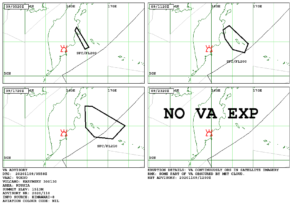 Since yesterday, the Karymsky erupts again ash clouds on Kamchatka (Russia). The VAAC issued 4 VONA warnings for air traffic. Volcanic ash was detected at 6000 m altitude. The ash drifted in northeast direction. Further eruptions of the remote volcano are expected.
Since yesterday, the Karymsky erupts again ash clouds on Kamchatka (Russia). The VAAC issued 4 VONA warnings for air traffic. Volcanic ash was detected at 6000 m altitude. The ash drifted in northeast direction. Further eruptions of the remote volcano are expected.
In the literature Karymsky is often mentioned as the most active volcano of Kamchatka. Until 2016, the volcano was permanently active and erupted several times a day. But this has changed significantly in the meantime. In the meantime, the Karymsky is active in phases and breaks of several months can occur. The Klyuchevskoy, which erupts more frequently and more strongly in the meantime, competes with the Karymsky.
Klyuchevskoy: Activity increases
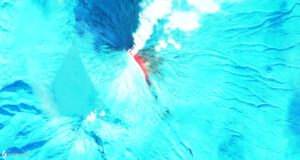 The volcano on Kamchatka put on an impressive performance yesterday. The output of lava increased. MIROVA registered the highest value of thermal radiation to date: 1454 MW. So the lava flow might have become longer than 1 km. At the moment a power of 1000 MW is still registered. On the LiveCam one could observe large strombolian eruptions. This morning an ash cloud was erupted. According to the VAAC it rose up to a height of 6000 m.
The volcano on Kamchatka put on an impressive performance yesterday. The output of lava increased. MIROVA registered the highest value of thermal radiation to date: 1454 MW. So the lava flow might have become longer than 1 km. At the moment a power of 1000 MW is still registered. On the LiveCam one could observe large strombolian eruptions. This morning an ash cloud was erupted. According to the VAAC it rose up to a height of 6000 m.
Etna: Swarm earthquake stronger
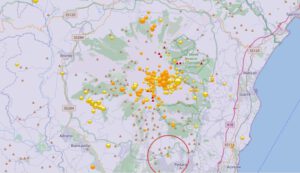 Already yesterday I reported about an earthquake swarm, which today presents itself much stronger than it first appeared. SismoWeb (INGV) today shows 53 earthquakes for November 5. Most of the tremors occurred about 2 km south of Pizzo Deneri on the northern side of Etna. The strongest single quake occurred on M 3.1 with a hypocenter at 3.2 km depth. The majority of the other quakes had magnitudes between 1 and 2. The hypocenters were mostly at depths less than 5 km. This was the strongest earthquake swarm of the last months at Etna. It is very well possible that the quakes were caused by rising magma. An eruption in the upper part of the Valle del Bove, respectively at the base of the Northeast Crater is possible in the medium term. However, it is known that the entire eastern flank of the volcano is moving and the quakes could also be related to tectonic processes.
Already yesterday I reported about an earthquake swarm, which today presents itself much stronger than it first appeared. SismoWeb (INGV) today shows 53 earthquakes for November 5. Most of the tremors occurred about 2 km south of Pizzo Deneri on the northern side of Etna. The strongest single quake occurred on M 3.1 with a hypocenter at 3.2 km depth. The majority of the other quakes had magnitudes between 1 and 2. The hypocenters were mostly at depths less than 5 km. This was the strongest earthquake swarm of the last months at Etna. It is very well possible that the quakes were caused by rising magma. An eruption in the upper part of the Valle del Bove, respectively at the base of the Northeast Crater is possible in the medium term. However, it is known that the entire eastern flank of the volcano is moving and the quakes could also be related to tectonic processes.
Vulkaneifel: Soil uplift at Laacher See proven
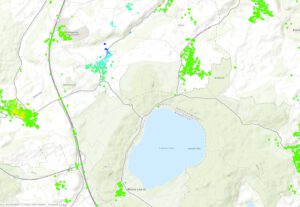 It has often been speculated whether a series of earthquakes at the Laacher Lake volcano, which occurred between 2013 and 2018, might not have been related to the intrusion of magmatic fluids. Now this assumption seems to be confirmed. The confirmation can be found in the form of a new map of the German authority BGR (Bundesanstalt für Geowissenschaften und Rohstoffe), which has been prepared within the framework of the Boden-Bewegungsdienst-Deutschland.
It has often been speculated whether a series of earthquakes at the Laacher Lake volcano, which occurred between 2013 and 2018, might not have been related to the intrusion of magmatic fluids. Now this assumption seems to be confirmed. The confirmation can be found in the form of a new map of the German authority BGR (Bundesanstalt für Geowissenschaften und Rohstoffe), which has been prepared within the framework of the Boden-Bewegungsdienst-Deutschland.
With the help of this map, primarily ground movements which have been caused by mining are to be represented. These are usually ground subsidence which can cause damage to the infrastructure. In fact, the satellites used to create the map did not only detect ground subsidence, but also ground uplift. It is located under the village of Glees, 2 km northwest of Lake Laach. The satellite data show that the ground rose by about 40 mm between 2014 and 2019.
In my opinion, the newly discovered ground uplift would justify a continuous observation of the Laacher See volcano and its surroundings, at least until it can be excluded that the ground deformation is of magmatic origin. Although it is still a small-scale uplift, without regular observation it is not known whether it is increasing. Theoretically an eruption could occur within a few months/years. If the fluid is magma.
Sinabung increases its activity
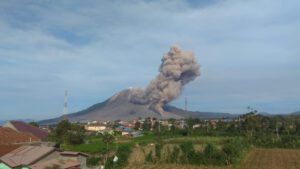 The volcano Sinabung is located on the Indonesian island of Sumatra and increased its activity. Already on October 20, the seismic activity increased rapidly, and in addition to volcanically induced earthquakes, numerous seismic signals were picked up, which were triggered by the discharge of debris avalanches. Yesterday at least one pyroclastic flow was generated, which was photographed but has not yet been included in the MAGMA/VSI updates. The stream had a length of about 1500 m and was active for almost 4 minutes. The events suggest that the lava dome has received a new growth spurt and reached a critical size. It is expected that further pyroclastic flows will be generated in the near future. There is also the danger that a larger part of the dome will collapse. Visual observations of the dome are rare these days because the top of the volcano is mostly hanging in the clouds.
The volcano Sinabung is located on the Indonesian island of Sumatra and increased its activity. Already on October 20, the seismic activity increased rapidly, and in addition to volcanically induced earthquakes, numerous seismic signals were picked up, which were triggered by the discharge of debris avalanches. Yesterday at least one pyroclastic flow was generated, which was photographed but has not yet been included in the MAGMA/VSI updates. The stream had a length of about 1500 m and was active for almost 4 minutes. The events suggest that the lava dome has received a new growth spurt and reached a critical size. It is expected that further pyroclastic flows will be generated in the near future. There is also the danger that a larger part of the dome will collapse. Visual observations of the dome are rare these days because the top of the volcano is mostly hanging in the clouds.
Etna: Video from the NE crater
Etna in Sicily is still active from 2 craters. Satellite images reveal 2 thermal anomalies: one originates from the New Southeast Crater, which is known to be strombolian active and has ejected ashes in phases a few days ago. The 2nd anomaly manifests itself in the Northeast Crater. The summiter Elia Finocchiaro climbed it yesterday and brought a nice video of the activity in the crater. Such images of Northeast Crater are rare. You can see 3 active vents from which lava sprays out. From one of the small vents a strombolian eruption was generated. Around the vents cones are already forming.
The tremor did not fluctuate as strongly in the past 2 days. But there were more earthquakes under the central crater area, in Valle del Bove and at the Pernicana fault zone. MIROVA registered a high thermal radiation with an output of 170 MW. Should such a value be measured repeatedly, there could be an intracrater lava flow.
Pacaya: Activity increased
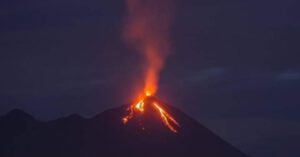 Yesterday the activity of Pacaya in Guatemala increased again. INSIVUMEH reports 3 active lava flows, which were extracted from different vents at the base of the McKenney crater. The longest flow reached a length of 400 m and flowed towards the northeast. The second flow was 300 m long and moved on the north flank, while a third lava flow on the west flank had a length of 200 m. Lava flows there did not occur during the last months. Furthermore, the McKenney crater was strombolian active. During the last night the activity seems to have decreased again a little bit: the only moderate heat radiation displayed by MIROVA indicates this.
Yesterday the activity of Pacaya in Guatemala increased again. INSIVUMEH reports 3 active lava flows, which were extracted from different vents at the base of the McKenney crater. The longest flow reached a length of 400 m and flowed towards the northeast. The second flow was 300 m long and moved on the north flank, while a third lava flow on the west flank had a length of 200 m. Lava flows there did not occur during the last months. Furthermore, the McKenney crater was strombolian active. During the last night the activity seems to have decreased again a little bit: the only moderate heat radiation displayed by MIROVA indicates this.
Etna with further earthquakes
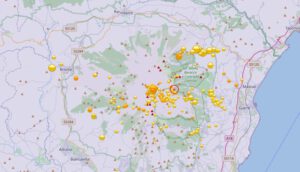 The day before yesterday there were several interesting earthquakes on Etna. The strongest one had a magnitude of 2.9 and manifested 1100 m east of the central crater. The hypocenter was located at a depth of only 700 m. In the same region there were 4 other quakes. In the north of the volcano, a quake M 2.7 occurred, which manifested itself at the Pernicana fault. This quake was also very flat. The INGV located the source of the earthquake at only 600 m depth. There was another quake M 1.2. The quakes at the fault zone are of tectonic origin, but could still be indicators for magma rise, because the magma can press on the fault zones and thus is able to trigger earthquakes.
The day before yesterday there were several interesting earthquakes on Etna. The strongest one had a magnitude of 2.9 and manifested 1100 m east of the central crater. The hypocenter was located at a depth of only 700 m. In the same region there were 4 other quakes. In the north of the volcano, a quake M 2.7 occurred, which manifested itself at the Pernicana fault. This quake was also very flat. The INGV located the source of the earthquake at only 600 m depth. There was another quake M 1.2. The quakes at the fault zone are of tectonic origin, but could still be indicators for magma rise, because the magma can press on the fault zones and thus is able to trigger earthquakes.
Of course Etna is not only seismically active, but also eruptive. In the last days eruptions from the saddle vent of the New South East Crater continued. Strombolians and phases with ash ejection occurred. The tremor fluctuates at the border of the red zone. There are no indicators for short-term changes in the eruption process. In the medium term a more intensive eruption phase could brew again.
Pacaya: Update 09.10.20
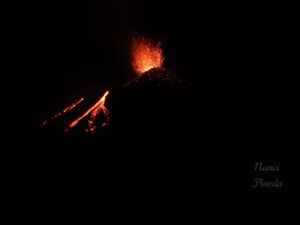 The Guatemalan volcano Pacaya is leading the headlines today because it erupts at least 2 lava flows. They originate from the base of the intracrater cone in the McKenney crater and generate a thermal signal with 333 MW power. The flows flow on the southeast and northeast flanks and split into several arms. Debris avalanches descend from the front of the flows. Exact longitude data are still missing. INSIVUMEH reported yesterday that there is only one stream on the south flank. It had a length of 250 m. The longer of the two rivers will be of this size today. Furthermore, the Pacaya is strombolian active and lets glowing tephra rise up to 100 m high. The eruption can be seen from Guatemala City. Numerous pictures were shared on Twitter.
The Guatemalan volcano Pacaya is leading the headlines today because it erupts at least 2 lava flows. They originate from the base of the intracrater cone in the McKenney crater and generate a thermal signal with 333 MW power. The flows flow on the southeast and northeast flanks and split into several arms. Debris avalanches descend from the front of the flows. Exact longitude data are still missing. INSIVUMEH reported yesterday that there is only one stream on the south flank. It had a length of 250 m. The longer of the two rivers will be of this size today. Furthermore, the Pacaya is strombolian active and lets glowing tephra rise up to 100 m high. The eruption can be seen from Guatemala City. Numerous pictures were shared on Twitter.
